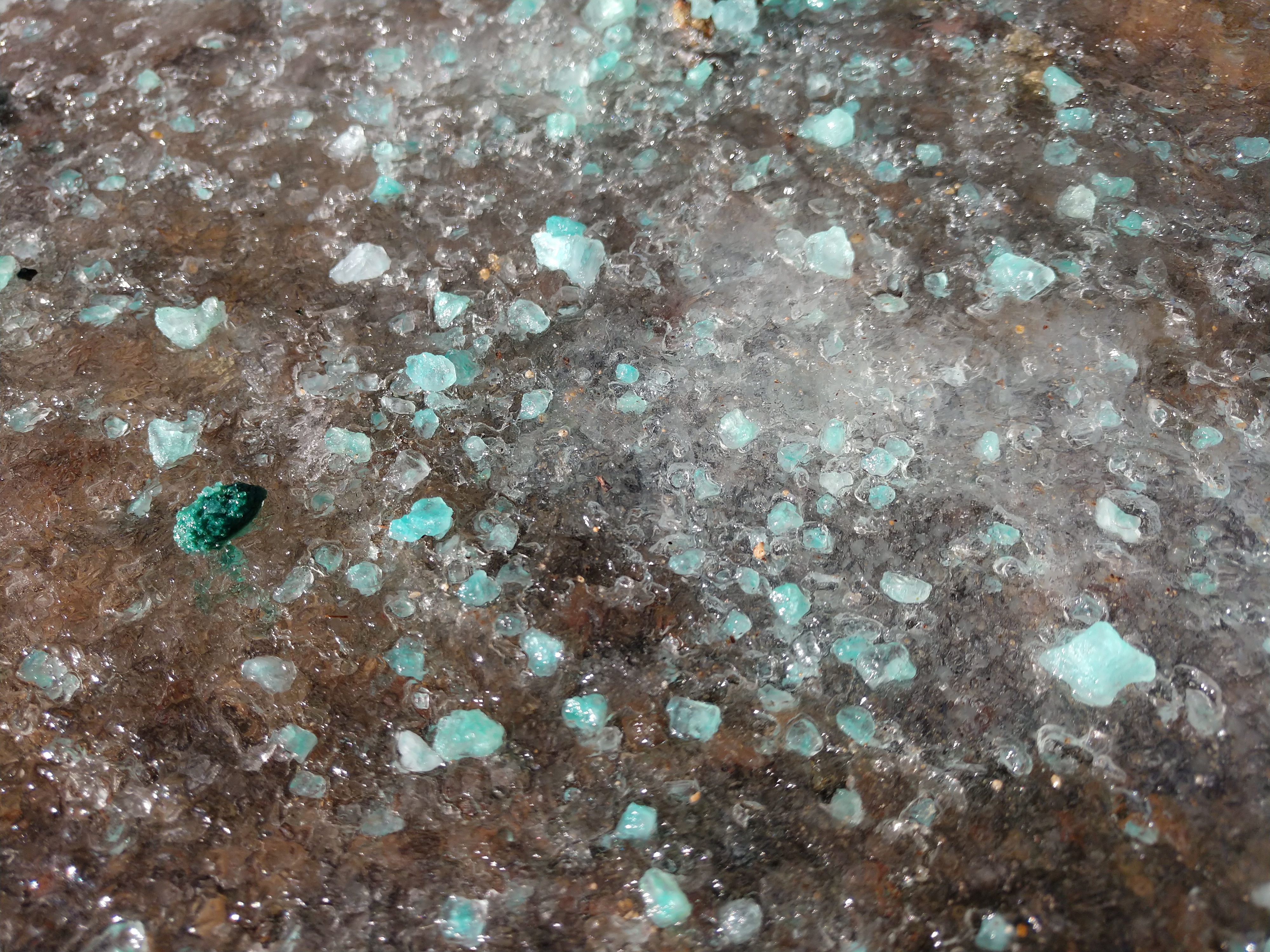 Deicing Compounds in the Landscape - January 15, 2020 Jeff Schalau, Agent, Agriculture & Natural Resources University of Arizona Cooperative Extension, Yavapai County Northern Arizona gets its fair share of snow and ice in winter and deicing compounds are a common way of enhancing safety and access. On north and east exposures, mechanical removal alone is often inadequate when ice accumulates on sidewalks, driveways, and road surfaces. For these situations, there are a number of products that chemically melt ice or physically improve traction; however, use of these materials is not without direct and indirect costs. These compounds can be expensive, and can damage vegetation, hardscaping, indoor carpet and flooring, vehicles, and the environment. Chemical deicers are often salts. Of these, sodium chloride (table salt) is the cheapest and most common. Others are calcium chloride, magnesium chloride, and potassium chloride. Chemical deicing works because solutions containing salt freeze at lower temperatures than pure water. Pure water freezes at 32 degrees F. Water with salt dissolved in it freezes at temperatures below 32 degrees F. Once a deicing compound is applied to a surface, it melts the ice, creating a brine solution with a freezing point lower than that of pure water. The process continues until all of the ice is melted, or the melt water dilutes the salt solution to a point where it refreezes. Because many factors are involved, there is no one material that is ideal for every situation. Select a deicing compound based on existing conditions such as temperature, the potential for damage, and public safety. Where possible, use deicing salts in moderation and combine with other management practices such as mechanical removal to reduce the amount of chemical needed and any subsequent impact to the landscape. Calcium, magnesium, and potassium chlorides are slightly less harmful to plants than sodium chloride. All are highly corrosive and can cause significant damage to landscape plants. Hardscape can be damaged when metal corrodes or when saturated deicer solutions are absorbed by rock, porous brick, or masonry causing a 10-20% expansion. Concrete can be formulated to be more resistant to scaling and cracking caused by salts and metal can be painted with corrosion resistant paints. Indoor surfaces are dulled and require more frequent cleaning where salts are used in adjacent outdoor areas. Sodium and potassium chloride salts are relatively easy to remove from floors and carpets. Calcium and magnesium chloride salts, however, leave a greasy film and require wet cleaning with detergents to remove the residue. Abrasives such as sand, cinders, and ash have relatively few impacts on the environment or plants. These materials do not melt ice but improve traction on slippery surfaces. The disadvantage of these materials is that they accumulate in the landscape, and may require frequent removal or create dust problems when they dry later in the year after deicing season. Calcium magnesium acetate (CMA) is a new, salt-free melting agent. It is made from dolomitic limestone and acetic acid (the main compound of vinegar). This material has little impact on plants and animals, is a good alternative for environmentally-sensitive areas. Each deicer has advantages and disadvantages. Planning a combined chemical and mechanical approach to snow and ice control can often minimize the impacts of deicer compounds to plants in the landscape. Use the following suggestions as you formulate your approach to deicing. Use more mechanical removal. The more snow and ice present, the more deicing compound is needed for melting. Reduced amounts can be used if large accumulations of snow and ice are removed first. The cost of labor for physical removal may be offset by savings in reduced damage to the landscape. If possible, select abrasives that can be incorporated into the landscape to reduce the need for removal after the deicing season. Use deicing compounds with minimal effects on plants. If possible, plant salt tolerant vegetation in areas receiving large amounts of deicing salt, or as a barrier between salt sensitive vegetation and the site of deicer application. Locate salt sensitive plants away from the site of deicer application and splash. Use hardscaping (gutters, barriers) to channel deicing solutions away from planting areas. When removing snow containing deicer residues, do not pile on or near salt sensitive plants. Irrigate areas where deicing compounds were used heavily in spring to leach accumulated salts from the root zone of plants. Additional information, including effective temperatures and potential negative effects, are included below. You can follow the Backyard Gardener on Twitter – use the link on the BYG website. If you have other gardening questions, call or email the Master Gardener help line in the Prescott (928-445-6590/prescottmg@gmail.com) or Camp Verde (928-554-8992/verdevalleymg@gmail.com) and be sure to include your name, address and phone number. Find past Backyard Gardener columns or provide feedback at the Backyard Gardener web site: http://cals.arizona.edu/yavapai/anr/hort/byg/.  Chemical deicer applied to a patch of ice (Photo by Jeff Schalau, University of Arizona).
Chemical deicer applied to a patch of ice (Photo by Jeff Schalau, University of Arizona).Additional Resources Deicing Coumpounds and Utah Landscapes, Utah State University Extension digitalcommons.usu.edu/cgi/viewcontent.cgi?article=1730&context=extension_histall Deicers and Plant Health, Penn State Extension extension.psu.edu/de-icers-and-plant-health Salt Damage in Landscape Plants, Purdue Extension www.extension.purdue.edu/extmedia/id/id-412-w.pdf |